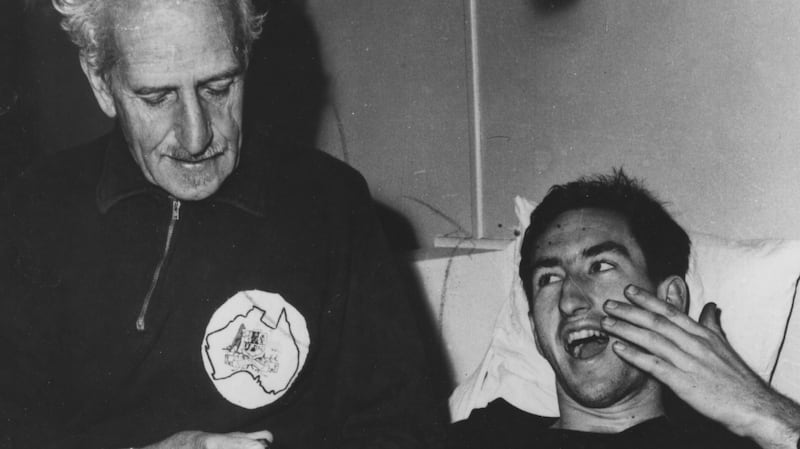I am running with my legs, and not on them. My knee lift is minimal and my arms are swinging just below waist level, softly tensioned as if carrying a bamboo stick in either hand. I have a small bowl of water on my head and my hips are lurched gently forward as if in the moment of deepest penetration.
Some people are taking this time of extra idleness and isolation to learn how to bake bread or play the drums. Others have more important choices to make. For me it’s been about learning to run for the first time all over again and if that’s not idleness and isolation well spent then what is?
Like many things in busier times the original lessons have become increasingly neglected: grabbing a quick run before breakfast, racing out before it gets dark, tearing strips off the Three Rock before jumping into the Jeep and driving to Kerry. Not good for the litheness and resolute ferocity that is the same posture and movement of the leopard, whether at rest, walking or running at full speed.
Depending on the exact mood or feeling of idle decay, my morning or evening run these days begins at the crossroads in Glencullen and heads along the only flat stretch of road through the glen itself, which coming from the city side is the first one of safe retreat within the Dublin and Wicklow Mountains.
It continues straight for another while before veering left down Boranaraltry Lane, turning sharply left again at the hairpin by the bridge over Glencullen River, then cuts straight back on itself and up the other side of the glen. It then crosses the Dublin-Wicklow border, drops and rises again, takes a quick detour around Raven’s Rock and the views across the distant bay, before re-emerging into Dublin again and up the last killer of a hill that is the Devil’s Elbow – all while staying safely within the 2km radius of my home.
It puts fresh meaning on the aloneness of the long-distance runner, and it’s a time to reflect in other ways too. I’ve been running most days since age 16, some weeks and months more than others, and by now my rough average of 30 miles a week will have taken me around the world, twice over. You do the math.
That doesn’t mean I don’t sometimes forget how to do it properly, beginning with some gentle stretching – hamstrings, groin, quads, back. There is a big difference between the good and bad techniques of running, as indeed the right and wrong ones, and no amount of practice will make it absolutely perfect. It helps to keep a conscious eye and ear out for both, especially in the long run.
It starts with the sound of the shuffle, because nothing will ruin the prospect of an accomplished run more effectively than starting out too fast. If there’s one thing I learned from training in Kenya (and no it wasn’t where to buy EPO) it’s that even they start out “painfully slow”, in their own words, a practice known as the “Kenyan shuffle”.

Of all my favourite running teachers over the years, and there have been many, the words of Percy Cerutty perhaps still ring most true. Best remembered as coach to the great Australian miler Herb Elliott, Cerutty also became deeply obsessed with correct running style. He studied the movements of animals and birds compared to humans, and figured out the ways in which we can learn from them.
To master his trade, he took his pupils to the sand dunes of Portsea, on the Victorian coast. Running barefoot on sand, he said, was the first step towards developing correct running style, and conviction too: “You might think you can run faster than me,” Cerutty would occasionally snarl at Elliott, “but you’ll never run harder than me.”
Cerutty grew up in extreme poverty and in 1942, at age 47, his health had failed so dramatically he decided to do something dramatic about it. He adopted a raw-food diet and embarked on a violent exercise regime. Five years later, at 52, he ran a marathon in exactly three hours. The first rule he tried to instil was that we “run with the legs, not on them” – that this was perhaps the most important factor of all in correct running style. “Shift all your weight to your upper body,” Cerutty would say, as that would create the conscious effort to run with the legs.
He was also a fan of the occasional barefoot run, without going all Born To Run about it. Running barefoot encourages the lifting of the leg with each stride, rather than landing on it – to focus that landing on the ball of the foot, rather than the heel. Any style of running that veers towards the opposite, as in pounding the surface, will inevitably result in that most common of injury, "runner's knee", or the vague yet nonetheless equally cursed injury known as "shin splints". So float, don't pound. He noted too how some of the best runners in history carry that gentle lean forward. Think Emil Zatopek, John Treacy, Hicham El Guerrouj.
No amount of conscious effort to run with the legs, not on them, will create the correct running style unless the hips are properly positioned. Over the years, several running coaches have emphasised this. Bill Bowerman, the co-founder of Nike, spelled it out plainly for his students at the University of Oregon, including Steve Prefontaine. The hips, Bowerman said, must be held up and forward at all times, "as if in the moment of deepest penetration".
When the lower body is sorted, the carriage of the arms, chest and shoulders is next. Cerutty also identified the thumb as one of the most neglected components of correct running style, the one thing that separates us from four-legged animals, but can also connect us to them. Only when the thumb is properly engaged, slightly pressed against the forefinger, can the hands and arms can become an equal driving force, a sort of two front legs. Carrying those bamboo sticks helps mimic that.
Once the arms are carried correctly, the shoulders will naturally drift back, and likewise, the chest stick out. Still the true engine of the runner is the heart and lungs – as that's where oxygen comes in. Breathing in and out efficiently is inevitably related to improving levels of fitness, and Noel Carroll, co-founder of the Dublin Marathon, had some good advice on that: "Don't worry about getting the air out, worry about getting the air in."
Slow and steady breathing in is always better than heavy puffing out. Ideally it should be two breaths in for every one breath out, without going the full Wim Hof about it. Ultimately, correct running style takes practice, even if that means learning some things all over again. Carroll had some good advice on that matter too: "If you find yourself too busy to run on any given day, then you're too busy." Especially in idle times like this.











